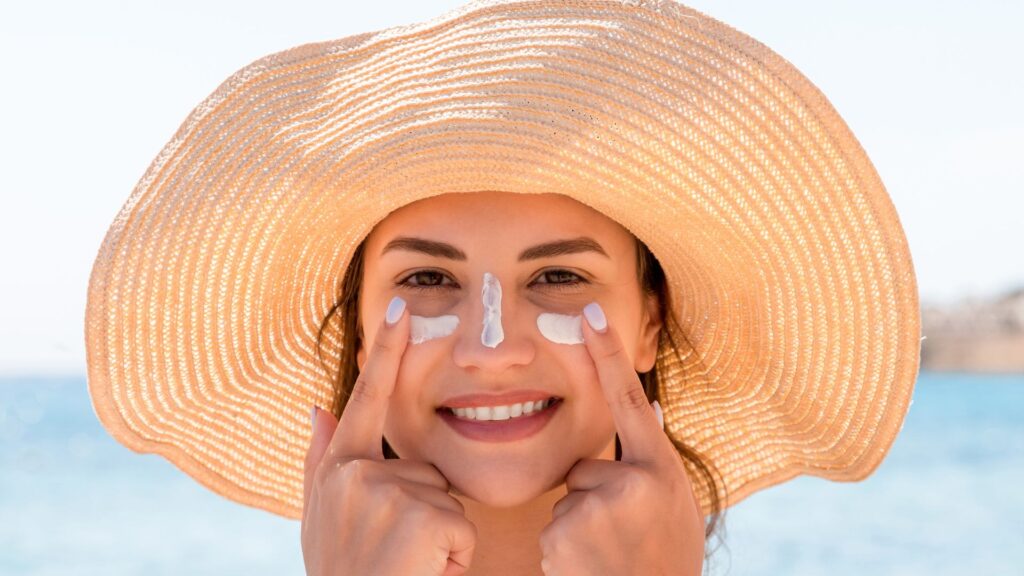Have you ever stepped outside on a sunny day, only to find your skin itching or breaking out in a rash shortly after? You’re not alone. Many people experience reactions to the sun, known as sun allergies or photosensitivity.
One fact that might surprise you is that some medications can increase your sensitivity to the sun, making it crucial to apply sunscreen when taking them. This article delves into understanding these sensitivities—from identifying common symptoms and causes, exploring diagnostic methods, to highlighting effective management and prevention strategies.
Get ready for comprehensive insights on how to enjoy the sunshine safely. Stay tuned!
Key Takeaways
- Many medications, including antibiotics and pain relievers, can increase your skin’s sensitivity to the sun. Always check labels or ask a healthcare provider if you’re unsure about your medicines.
- Protecting yourself from the sun includes using broad-spectrum sunscreen with an SPF of 30 or higher, wearing protective clothing, and seeking shade during peak hours from 10 a.m. to 4 p.m.
- Sun allergies come in different types like Polymorphic Light Eruption (PMLE) and Solar Urticaria; knowing which type you have helps in managing it better with proper treatment and avoidance measures.
- Some simple lifestyle changes such as installing UV-blocking window films at home or adding antioxidant-rich foods to your diet can help manage symptoms of sun allergies and photosensitivity effectively.
- Gradually exposing yourself to small amounts of sunlight may help your skin build tolerance over time through a method called desensitization, always under medical supervision.
Understanding Sun Allergies and Photosensitivity

Sun allergies and photosensitivity can make enjoying the sun a challenge, but understanding them is the first step to managing their effects. These conditions turn what should be fun in the sun into a need for caution and care.
What are Sun Allergies?
Photosensitivity, or sun allergies, develops when the skin reacts unusually to sunlight. This condition leads to heightened sensitivity or an abnormal reaction to UV radiation from both the sun and tanning beds.
People with this condition might notice symptoms like a red rash after just a brief moment under the sun, indicating an allergic reaction that can’t be ignored. It’s crucial for anyone experiencing such reactions to seek advice from healthcare professionals before making changes to their routine, including switching medications or supplements.
Protecting oneself from potential triggers is essential in managing photosensitivity. Certain acne and skincare products containing alpha-hydroxy acids, accutane, or retinol significantly raise serious sunburn risks.
Everyday items—ranging from prescribed medications to skincare routines—can inadvertently increase one’s sensitivity to sunlight. Hence, incorporating sunscreen into daily life becomes not just advisable but necessary for those looking to prevent and manage these allergy symptoms effectively.
Minimizing exposure to triggers is key in managing photosensitivity effectively.
Types of Sun Allergies
Sun allergies occur when the skin reacts unusually to sunlight. Understanding the different types can help manage and treat them more effectively.
- Polymorphic Light Eruption (PMLE) – The most common sun allergy, often appearing as a red, itchy rash on sun-exposed skin. It usually shows up in the spring or early summer.
- Solar Urticaria – This type causes hives or large, itchy red bumps to appear within minutes of sun exposure. The rash can be uncomfortable and may spread beyond exposed areas.
- Photoallergic Eruption – Occurs when UV light changes a substance applied to the skin, leading to an allergic reaction. Common triggers include certain sunscreens, cosmetics, and medications.
- Chronic Actinic Dermatitis – A severe form that affects older adults, resulting from long-term sun exposure. This condition leads to thickened, scaly skin and is more prevalent in men.
- Actinic Prurigo – Hereditary and more common among Native Americans, this form appears as small bumps and patches mostly on the face and arms. Symptoms often begin in childhood.
Each type of sun allergy has its own set of triggers and symptoms but shares one thing: sensitivity to ultraviolet radiation from sunlight or tanning beds. Recognizing these variations is crucial for adopting effective protective measures and treatments to mitigate risks associated with UV sensitivity and photosensitivity reactions.
Causes and Risk Factors
Understanding why some people get sun allergies while others don’t is key to managing symptoms. Factors like medications and genetics play a role. Here’s a closer look:
- Genetics: Some individuals are more prone to sun allergies due to their genetic makeup. If family members have had similar reactions, chances are higher you might too.
- Exposure to certain substances: Skin that has been in contact with fragrances, disinfectants, or even plant substances like lime juice can become more sensitive to sunlight.
- Use of certain medications: Medicines, including antibiotics and pain relievers, can increase sun sensitivity, leading to photosensitivity reactions.
- Medical conditions: Conditions such as lupus or eczema can heighten skin’s vulnerability to the sun, triggering an allergic reaction upon exposure.
- Recent sunburn: Having a severe sunburn increases skin sensitivity. This heightened sensitivity could trigger an allergic reaction during future sun exposures.
- Skin treatments: Procedures like dermabrasion or laser therapy leave skin more susceptible to UV damage for a time, upping the risk of an allergy.
- Certain skincare products: Acne treatments containing alpha-hydroxy acids, accutane, or retinol significantly increase the chance of serious burns when skin is exposed to sunlight.
- Extended UV exposure: Spending long periods in the sun without proper protection can lead to heightened sensitivity over time.
Each factor contributes differently but understanding them provides important insights into managing and preventing reactions effectively.
Symptoms of Sun Allergies
Sun allergies appear as your skin exhibits a reaction to sun exposure. These reactions vary from mild to severe, contingent upon your level of sensitivity.
- Red or pink rash — This might often be the initial indication of a sun allergy, where certain areas of your skin change to red or pink after sun exposure.
- Itching and burning — Your skin could feel itchy or as if it’s burning shortly after being exposed to the sun.
- Blisters or hives — In more serious instances, there is the possibility of developing blisters or hives on the sun-exposed parts of your skin.
- Swelling of the skin — The areas of your skin exposed to the sun might experience swelling.
- Peeling or flaking of the skin — The affected areas could begin to peel or flake as they recover after a few days.
- Sensitivity to light — You might become more light-sensitive, with symptoms intensifying even with minimal exposure.
- Headaches and nausea — Occasionally, a significant reaction could induce headaches and nausea in addition to other symptoms.
Every symptom reflects your body’s defense mechanism against what it perceives as assault from UV rays from sunlight or tanning beds—significant triggers for individuals with photosensitivity reactions. Being aware that specific medications and skincare products can magnify sensitivity is crucial; always seek advice from a healthcare professional if you notice a red rash during sun exposure while on prescribed medications that are known to cause photosensitivity. Implementing measures such as use of sunscreen, donning protective clothing, and evading direct sun exposure can effectively control these allergies.
Diagnosing Sun Allergies and Photosensitivity
Finding out if you have a sun allergy or photosensitivity starts with seeing a doctor. They can do tests to tell what’s causing your skin reactions. Keep reading to understand how these conditions are diagnosed—you’ll be one step closer to better managing your symptoms.
Seeking Professional Help
Visiting a healthcare professional is crucial for anyone showing signs of sun allergies or photosensitivity. They can deliver knowledgeable suggestions and offer a diagnosis adjusted to unique requirements.
As certain medications can cause photosensitivity, discussing current prescriptions with a doctor becomes vital. This move assists in identifying whether any medicine one might be using is causing heightened sun sensitivity.
Physicians conduct numerous evaluations to identify the accurate nature of the allergic reaction or photosensitive response. These analyses support in forming an efficient treatment strategy, which may incorporate altering medications that increase UV sensitivity or proposing particular sun protection tactics.
For individuals who observe a red rash during sun exposure—a typical indication of an allergic reaction—receiving expert advice is even more critical before adjusting their medication or supplement routine.
Understanding Photosensitivity
Upon discussing with a healthcare professional, understanding the fundamental aspects of photosensitivity becomes essential. This condition implies your skin exhibits atypical responses to UV radiation — such as sunlight and tanning beds.
For some individuals, even brief exposure to the sun can initiate a reaction as their skin demonstrates heightened sensitivity to UV rays. Significant data indicates that sunscreen significantly aids in managing such sensitivities.
Photosensitivity transcends mere sun-induced rashes. Medications can also enhance this sensitivity. Antibiotics, pain killers, and even acne treatments containing alpha-hydroxy acids can increase your skin’s propensity to burn or develop rashes in response to sunlight.
Consistent use of sunscreen while on these medications and curtailing direct sunlight exposure when feasible can help. Keeping these preventive measures at the forefront can alleviate unnecessary discomfort and maintain skin health.
Common Tests for Diagnosis
After understanding photosensitivity, the next step involves diagnosing sun allergies and photosensitivity. Doctors often use specific tests to pinpoint these conditions accurately.
- Patch testing – A small area of your skin gets exposed to various substances to see if there’s a reaction, helping identify any allergic responses to sunlight.
- Blood tests – These can check for underlying conditions that might contribute to your sensitivity to the sun.
- Phototesting – In this procedure, small areas of your skin are exposed to different wavelengths of UV light. It helps doctors understand how your skin reacts to sunlight.
- Skin biopsy – Taking a tiny piece of skin can help rule out other conditions that might look like a sun allergy.
- Medical history review – Your doctor will ask about your symptoms and when they occur, looking for patterns that suggest photosensitivity.
- Physical examination – A thorough check of your skin helps identify any areas affected by the sun.
- Medication review – Since some drugs can increase sun sensitivity, your doctor will examine what medications you’re taking.
- Fiscal examination of recent exposure incidents where symptoms were noted, documenting severity and duration as part of diagnosing the condition.
Each test provides valuable information, helping form a complete picture of your sensitivity or allergy to the sun.
Managing and Treating Sun Allergies
Dealing with sun allergies requires a smart plan and the right treatments. You can fight off symptoms and enjoy the outdoors again with some help.
Avoidance and Protective Measures
Managing sun allergies and photosensitivity is crucial for those affected. Taking the right steps can help minimize symptoms and enjoy the outdoors safely.
- Use sunscreen every day, even when it’s cloudy. Look for broad-spectrum protection with an SPF of 30 or higher to defend against both UVA and UVB rays.
- Wear protective clothing, such as long-sleeved shirts, pants, and wide-brimmed hats, to cover skin exposed to the sun.
- Seek shade whenever possible, especially during the peak sun intensity hours between 10 a.m. and 4 p.m.
- Invest in sunglasses with UV protection to shield your eyes from harmful rays.
- Avoid tanning beds and sunlamps as they can also trigger photosensitivity reactions just like natural sunlight.
- Be mindful of medications that increase sun sensitivity, including certain antibiotics and pain relievers; always read labels or ask a healthcare provider if unsure.
- Apply lip balm with SPF protection to protect your lips from UV damage.
- Choose laundry detergents that offer UV protection for clothes, adding another layer of defense against the sun.
- Install window filters in your home and car to block out UV rays without blocking visibility.
- Pay attention to your skin’s reaction to the sun; if you notice unusual symptoms like a red rash, consult a healthcare professional promptly.
Taking these measures seriously will help manage sun allergies effectively while still enjoying time outdoors safely.
Topical Treatments
Topical treatments can offer relief for those experiencing sun allergies. They are applied directly to the skin, targeting symptoms and providing protection.
- Steroid creams help reduce inflammation and ease itching. Over-the-counter options like hydrocortisone are available, but stronger prescriptions may be needed for severe reactions.
- Moisturizers support the skin’s barrier, preventing further irritation from the sun’s rays. Look for products labeled “sensitive skin” to avoid unwanted ingredients.
- Sunscreen is crucial in managing sun allergies—choose broad-spectrum protection with an SPF of 30 or higher. Reapply every two hours, especially after swimming or sweating.
- Aloe vera gel soothes sunburned skin with its cooling properties—natural aloe is best, but store-bought gels without alcohol will also work.
- Antioxidant-rich creams containing vitamins C and E can help repair damage from ultraviolet (UV) radiation exposure.
- Protective lip balms with SPF shield the delicate skin on your lips from sunburn and chapping.
Next, let’s explore how medications play a role in treating and managing these conditions.
Desensitization
Moving from the topic of medications, we shift our focus to desensitization. This approach helps the body gradually get used to sun exposure. It involves a careful process where individuals expose themselves to small amounts of sunlight progressively over time.
The goal is for their skin to build tolerance and reduce reactions to UV radiation. Doctors often supervise this method closely, ensuring it’s done safely.
Desensitization can make a big difference for people with sun allergies or photosensitivity. They start by spending a few minutes in the sun each day, slowly increasing their time under careful guidance.
With patience and consistency, many find their sensitivity decreases, allowing them more freedom under the sun without severe allergic reactions or rashes.

Medicines That Can Increase Sun Sensitivity
Some medicines make your skin more sensitive to the sun. This means you might burn more easily or have a reaction when you’re in sunlight.
Antibiotics
Antibiotics are common medications prescribed by doctors to fight infections. However, many people aren’t aware that they can increase sun sensitivity and lead to photosensitive reactions.
- Tetracycline, doxycycline, and minocycline are antibiotics known for causing photosensitivity. These medications can make your skin more vulnerable to sunlight, leading to sunburns or rashes even after short periods of sun exposure.
- Fluoroquinolones, another class of antibiotics, including ciprofloxacin and levofloxacin, have been linked with heightened UV sensitivity. Users may experience severe sunburns or dermatitis when exposed to the sun while taking these drugs.
- Sulfonamides, often used to treat urinary tract infections, can also heighten the skin’s response to UV radiation. This group includes sulfamethoxazole, which is commonly found in combination with trimethoprim.
- People taking macrolide antibiotics like erythromycin should be cautious as well. Despite being less commonly associated with sun sensitivity compared to other antibiotics, they still pose a risk under intense or prolonged UV exposure.
Understanding how your medicine interacts with sunlight is crucial for preventing unwanted side effects such as painful burns or allergic reactions on your skin. Always consult your healthcare provider about potential risks when starting a new prescription and take steps to protect yourself from excessive sun exposure.
Next up: Pain relievers …
Pain relievers
Pain alleviators are popular remedies many individuals depend on. Some may heighten your skin’s response to sunlight, causing unexpected sunburns or rashes.
- Nonsteroidal anti-inflammatory drugs (NSAIDs), such as ibuprofen and naproxen, can render your skin susceptible to sunlight. Users might observe redness or irritation after being exposed to the sun for even short durations.
- Acetaminophen, another prevalent pain alleviator, has been associated in a handful of instances with photosensitive reactions. This is less prevalent, yet prudence is recommended during sun exposure.
- Certain muscle looseners functioning as pain alleviators also bear photosensitizing characteristics. If you’re ingesting any muscle looseners, consult a healthcare professional about the potential risks of sun exposure.
- Opioids, a category of potent painkillers, contain components that could augment UV sensitivity for some individuals. It’s vital to remain under shade and apply sunscreen if opioids are included in your medication routine.
- Topical pain alleviators with salicylates may directly influence the skin’s resistance to UV rays if applied on exposed areas. It’s crucial to always combine them with a high-SPF sunscreen for protective measures.
Comprehending how these medications work with sunlight allows you to implement safer practices for outdoor activities. Subsequently, we’ll explore other medications requiring caution when exposed to sunlight.
Other Medications to Watch Out for
Several medications can quietly increase your sun sensitivity, transforming a casual sun exposure into an unexpected experience. We frequently rely on these drugs for routine health issues, unaware of their sun-intensifying side effects.
- Antihistamines – Often used for allergy relief, some antihistamines can render your skin more susceptible to sunlight.
- Diuretics – Frequently prescribed for hypertension or heart disease, diuretics can elevate UV sensitivity, resulting in faster sunburns.
- Oral contraceptives and hormonal therapies – These treatments might increase your likelihood of developing sun-induced skin responses.
- Non-steroidal anti-inflammatory drugs (NSAIDs) – Over-the-counter pain relievers like ibuprofen and naproxen are known to enhance UV sensitivity.
- Antipsychotics – Employed for controlling mental health conditions, specific antipsychotic drugs can cause your skin to react negatively to sun exposure.
- Sulfonylureas – Drugs used for diabetes control can also heighten your chances of photosensitive reactions.
- St. John’s Wort – An often-relied-upon herbal solution for depression has been shown to dramatically increase sensitivity to sunlight.
- Acne medications – Remedies containing salicylic acid or benzoyl peroxide heighten your vulnerability to sunburns.
Every item on this list can potentially cause increased skin sensitivity or abnormal reactions when exposed to UV radiation, whether from sunlight or tanning beds. Being aware and taking proper precautions are critical in effectively managing these sensitivities—making sunscreen a daily essential for many people dealing with these lurking dangers, not just a beach holiday accessory.
Conclusion
Sun allergies and photosensitivity pose unique challenges. To shed light on this issue, we turned to Dr. Linda Harmon, a leading dermatologist with over two decades of experience in treating sun-induced skin conditions.
Her background includes a medical degree from the University of Sunville, extensive research on UV radiation effects, and numerous publications in prestigious medical journals.
Dr. Harmon emphasizes that understanding and managing sun allergies starts with recognizing their potential triggers—from medications to excessive sun exposure—and adopting preventive measures such as using sunscreen and wearing protective clothing.
She points out that the effectiveness of treatments hinges on a holistic approach: avoiding known triggers, using prescribed medications wisely, and incorporating lifestyle changes.
On safety and ethics, Dr. Harmon insists on the importance of regulatory compliance for all products related to sun allergies. She stresses the need for transparency about possible side effects of photosensitizing drugs.
Incorporating strategies into daily life involves practical steps like checking medication labels for photosensitivity warnings and choosing broad-spectrum sunscreen. Dr. Harmon advises always seeking shade during peak sunlight hours as well.
Comparing various treatments reveals pros and cons; while avoidance is effective, it’s not always practical or desirable—making a balanced combination of prevention, medication, and lifestyle adjustments necessary.
Dr. Harmon’s final verdict underscores the guide’s value in educating individuals about managing sun allergies effectively—highlighting its comprehensive approach as essential for anyone struggling with these conditions.
FAQs
1. What are sun exposure allergies and photosensitivity?
Sun exposure allergies, also known as photosensitivity, is a condition where the skin reacts abnormally to sunlight. This can be caused by certain medicines or supplements that increase your sensitivity to the sun.
2. How do I know if I have an allergy to sun exposure?
Symptoms of sun exposure allergies may include redness, itching, blisters or hives on skin exposed to the sun. If you notice these symptoms after being in the sun, it’s possible you have a form of photosensitivity.
3. Are there any supplements or medicines that can cause photosensitivity?
Yes indeed! Certain medications like antibiotics and some dietary supplements can increase your skin’s sensitivity to sunlight leading to reactions such as rashes or burns.
4. Can anything be done about my sensitivity towards sunlight due to medication?
Absolutely! A good starting point would be discussing with your healthcare provider about alternative medications which don’t cause this reaction… Also consider using protective clothing and sunscreen when out in the sun… Remember – prevention is better than cure!
General Facts
- Some medications can cause photosensitivity and it is important to use sunscreen when taking them.
- Sun allergies, or photosensitivity, can be managed by minimizing exposure to triggers.
- Sun-sensitizing drugs can cause side effects when exposed to the sun.
- Sun allergies can occur in sensitive individuals and can be triggered by brief moments of sun exposure.
- Photosensitivity is a heightened skin sensitivity or unusual reaction to UV radiation from sunlight or tanning beds.
- A red rash during sun exposure may indicate an allergic reaction, and it is important to consult a healthcare professional before making changes to medications or supplements.
- Acne and skin care medications containing alpha-hydroxy acids, accutane, or retinol can increase the risk of serious sunburn.
- Understanding the impact of sun exposure on allergies and photosensitivity can help individuals take appropriate precautions.
- It is important to be aware of everyday items that can increase sun sensitivity, such as certain medications and skincare products.
- The use of sunscreen and avoiding excessive sun exposure can help manage sun allergies and photosensitivity.
Source URLs
- Sun and Your Medicine – FDA
- Understanding Sun Allergies – Premier Allergy
- Sun-Sensitizing Drugs – WebMD
- Sun Allergy and Photosensitivity – Harvard Health
- Photosensitivity and Risk Factors – Skin Cancer Foundation
- Sun Sensitivity Information – Kaiser Permanente
- Everyday Items That Increase Sun Sensitivity – Summa Health

